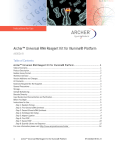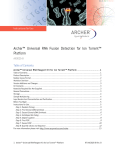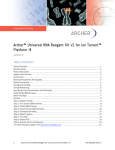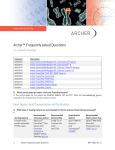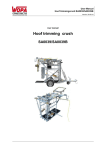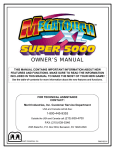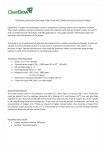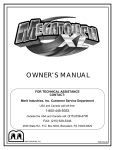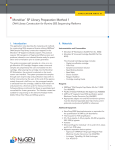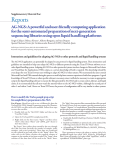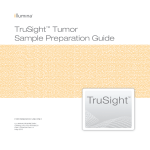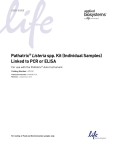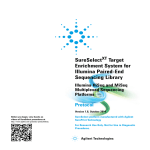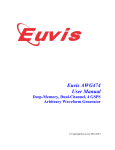Download Archer™ Universal DNA Reagent Kit v2 for Illumina®
Transcript
Instructions for Use Archer™ Universal DNA Reagent Kit v2 for Illumina® AK0037-8 Table of Contents Archer™ Universal DNA Reagent Kit v2 for Illumina® ......................................................................................1 Table of Contents................................................................................................................................................................. 1 Revision History ................................................................................................................................................................... 2 Product Description ............................................................................................................................................................. 2 Modular Assay Format ......................................................................................................................................................... 2 Workflow Overview .............................................................................................................................................................. 3 Kit Contents ......................................................................................................................................................................... 3 Materials Required But Not Supplied................................................................................................................................. 3 General Precautions ............................................................................................................................................................ 4 Storage and Handling .......................................................................................................................................................... 4 Sample Multiplexing ............................................................................................................................................................ 4 Barcode Diversity ................................................................................................................................................................. 4 Input Nucleic Acid Concentration and Purification .......................................................................................................... 5 Before You Begin .................................................................................................................................................................. 5 Removal of Divalent Cations and EDTA from Input Nucleic Acid .................................................................................... 5 Protocol................................................................................................................................................................................. 6 Step 1: Fragmentation, End Repair, dA-Tailing ................................................................................................................. 6 Step 2: Adapter Ligation ...................................................................................................................................................... 7 Step 3: First PCR ................................................................................................................................................................. 8 Step 4: Second PCR ............................................................................................................................................................. 9 Step 5: Quantify Library and Sequence............................................................................................................................11 For more information please visit http://www.archerdx.com...................................................................................... 12 1 Archer™ Universal DNA Reagent Kit v2 for Illumina® IFU-AK0037-8 Rev. B Revision History From Rev To Rev A B Change Deleted PCR1 and PCR2 cycling conditions, refer to the panel-specific Instructions for Use. Deleted MiSeq and NextSeq loading recommendations refer to the panel-specific Instructions for Use. Product Description The Archer Universal DNA Reagent Kit v2 for Illumina can be used in conjunction with Archer DNA assays, utilizing the power of next-generation sequencing to improve mutation detection. The kit contains reagents necessary to perform library preparation on various sample types. Modular Assay Format The Archer Universal DNA Reagent Kit v2 for Illumina used in conjunction with Archer assays and Molecular Barcode (MBC) Adapters, allows users to construct Illumina MiSeq® or NextSeq®-ready libraries from total nucleic acid or DNA samples. For Research Use Only. Not for use in diagnostic procedures. 2 Archer™ Universal DNA Reagent Kit v2 for Illumina® IFU-AK0037-8 Rev. B Workflow Overview Kit Contents 1. 2. 3. 4. 500 mM Tris-HCl, pH 8.0 (SA0020) Ultra Pure Water (SA0021) Ultra Pure Water for Ethanol Dilution (SA0022) Lyophilized Reagents: a. Step 1: Fragmentation, End Repair, dA-Tailing (SA0039) b. Step 2: Adapter Ligation (SA0005) c. Step 3: First PCR (SA0109) d. Step 4: Second PCR (SA0110) Materials Required But Not Supplied 1. 2. 3. 4. 5. 3 Archer MBC Adapters for Illumina Agencourt® AMPure® XP Beads (Cat# A63881) Life Technologies™ DynaMag (Cat# 12331D) 100% ethanol (ACS grade) KAPA Biosystems® Library Quantification Kit - Illumina/Universal (Cat# KK4824) Archer™ Universal DNA Reagent Kit v2 for Illumina® IFU-AK0037-8 Rev. B 6. Archer VariantPlex Panel 7. If nucleic acid is from FFPE tissue, it is recommended to use Agencourt FormaPure® (Cat# A33342) for extraction 8. Illumina MiSeq Reagent Kit v2 or v3 9. NextSeq 500 Mid Output v2 300 cycle (Cat# FC-404-2003) 10. NextSeq 500 High Output v2 300 cycle (Cat#FC-404-2004) General Precautions • • • • • • Read the entire protocol before beginning. Take note of stopping points where samples can be frozen at -20°C and plan your workflow accordingly. Use good laboratory practices to minimize cross-contamination of nucleic acid products. Always use PCR tubes, microfuge tubes and pipette tips that are certified sterile, DNase and RNasefree. Before starting, wipe down work area and pipettes with an RNase and DNA cleaning product such as RNase Away (Molecular BioProducts, Inc. San Diego, CA). For consistent library amplification, ensure the thermal cycler used in this protocol is in good working order and has been calibrated to within the manufacturer’s specifications. Storage and Handling All components of Archer Universal DNA Reagent Kit v2 for Illumina (Part # AK0037-8) should be stored between 2°C and 8°C. The liquid GSP1 and GSP2 primer tubes should be stored between -10 °C and -30 °C. Allow pouches to warm to room temperature before opening. Sample Multiplexing In order to efficiently utilize the throughput of the MiSeq or NextSeq, multiple samples should be sequenced simultaneously. Samples can be identified through a unique nucleotide sequence that is part of the molecular barcode adapter ligated to the nucleic acid sequence of interest during library construction, and which is subsequently read during the sequencing process. The unique nucleotide sequence is often termed an “index”. The Archer Universal DNA Reagent Kit v2 for Illumina utilizes a combination of two indices to distinguish between samples. The first index is added just before Step 2 (Adapter Ligation) and is embedded in the Archer MBC Adapters for Illumina. The second index is added in Step 4 (Second PCR) and is embedded in Illumina Index 1 Primers within the PCR2 lyophilized pellets. In order to maintain appropriate coverage depth, it is recommended that users determine the maximum number of samples that can be run on a MiSeq or NextSeq flow cell. In general, larger panels with more targets will require higher sequencing coverage depth and should be run with fewer samples. Refer to the applicable VariantPlex Panel instructions for use for multiplexing recommendations. Barcode Diversity The Illumina MiSeq and NextSeq will work best when index diversity within a run is high. For example, if eight samples are included in a run, and the user chooses to use only one MBC Adapter paired with eight different 4 Archer™ Universal DNA Reagent Kit v2 for Illumina® IFU-AK0037-8 Rev. B Illumina Index 1 Primers, the run may fail due to low barcode diversity. In this example it is best to use eight different Archer MBC Adapters paired with eight different Illumina Index 1 Primers. Input Nucleic Acid Concentration and Purification • • • Recommended Input: Start with 100 ng – 200 ng of total nucleic acid input or 50 ng – 100 ng of purified DNA. Be sure that DNA is in buffers that do not contain EDTA (i.e. use Tris-HCl and not Tris-EDTA buffer). For DNA or total nucleic acid stored in buffers containing EDTA, an initial buffer exchange with Agencourt AMPure XP Beads is required before DNA fragmentation. Because total nucleic acid from Agencourt FormaPure extraction of FFPE sources is eluted in EDTA-free buffer, you may proceed directly to step 1.2. and skip AMPure XP cleanup of your sample. In step 1.7. add 100 ng – 200 ng of total nucleic acid in a total volume of 50 µL. If you are using a kit other than FormaPure carefully check the contents of the final storage buffer to determine if it contains EDTA or divalent cations. Before You Begin • • Make fresh 10 mM Tris-HCl. o Mix 30 µL 500 mM Tris-HCl, pH 8.0 (SA0020) with 1470 µL Ultra Pure Water (SA0021). Make fresh 70% ethanol. o Add 14 mL 100% ethanol (ACS grade; not included) to entire bottle containing Ultra Pure Water for Ethanol Dilution (SA0022). o Note the date on which ethanol is added, 70% ethanol is appropriate for use for one week after mixing. When not in use, tightly close the bottle cap to minimize evaporation. Removal of Divalent Cations and EDTA from Input Nucleic Acid Note: If your input DNA or total nucleic acid is already free of divalent cations and EDTA skip to step 1.2. 1.1. Purify DNA or total nucleic acid with AMPure XP beads. Note that some total nucleic acid or DNA will be lost during purification so provide 2x the amount needed for library preparation 5 1.1.1. If the DNA or total nucleic acid is in a volume of less than 50 µL, adjust the volume to 50 µL with Ultra Pure Water. If the volume is greater than 50 µL, scale the volume of AMPure XP beads appropriately (see step 1.1.2.). 1.1.2. Add 90 µL of AMPure beads to the reaction for a ratio of 1.8X. If the DNA or total nucleic acid is in a volume greater than 50 µL, scale the volume of AMPure up such that the ratio of AMPure to DNA ratio is 1.8X. Make sure that AMPure XP Beads are fully resuspended by vortexing prior to adding the sample. 1.1.3. Vortex well or pipette 10 times to mix and visually inspect the color of the sample to ensure a homogenous mixture. 1.1.4. Incubate for 5 minutes at room temperature. 1.1.5. Place tubes on magnet for 2-4 minutes or until beads are pelleted and solution is clear. 1.1.6. Carefully pipette off and discard supernatant without disturbing the beads. Archer™ Universal DNA Reagent Kit v2 for Illumina® IFU-AK0037-8 Rev. B 1.1.7. Without disturbing the separated beads, wash by adding 200 µL of 70% ethanol while on the magnet and incubate for 30 sec at room temperature. Carefully remove ethanol and discard. Repeat this procedure for a total of 2 washes. 1.1.8. After the final wash, briefly spin down and carefully remove remaining supernatant while taking care not to disturb the beads. With caps open, dry beads at room temperature for 5 minutes. Take care not to over dry the beads as this can reduce yield. 1.1.9. Remove tubes from the magnet and elute DNA by thoroughly resuspending the beads in 55 µL 10mM Tris-HCl. 1.1.10. Place the AMPure bead solution back on magnet for 2 minutes. 1.1.11. Carefully transfer 53 µL of the clean DNA solution to a fresh 200 µL PCR tube. Be sure to avoid transferring beads to the fresh tube. Ensure that your starting input is still 100-200ng total nucleic acid or 50-100ng DNA. You may reserve 2 µL of the eluate to measure the concentration or quality of the input material. Protocol Step 1: Fragmentation, End Repair, dA-Tailing 1.2. Enter the following program into a thermal cycler and start the program. Be certain to set the instrument’s heated lid set to ≥100°C. When the thermal cycler block reaches 4°C, pause the program. Step 1 2 3 4 Incubation Temperature 4°C 37°C 72°C 4°C Incubation Time 1 min 12 min 20 min Hold 1.3. Gently open the Fragmentation, End Repair, dA-Tailing (SA0039) foil pouch by tearing along the indents located at the top of the silver package. 1.4. Remove the blue 8-tube strip. Each tube in the strip provides a single reaction. 1.4.1. If you would like to use fewer than 8 reactions, carefully detach the appropriate number of tubes using clean scissors or a new razor blade. Store the remaining unused tubes at 4°C in the sealed foil pouch with the provided desiccant. 1.5. Centrifuge briefly to ensure lyophilized material is in the bottom of the tube. 1.6. Place the DNA Fragmentation, End-Repair, dA-Tailing reaction tubes on ice. 1.7. Transfer 50 µL of the DNA (from step 1.1.11. if cleanup was necessary) to the Fragmentation, EndRepair, dA-Tailing reaction tubes. Gently resuspend the lyophilized pellet by pipetting up and down 4 or 5 times while keeping the tubes on ice, then centrifuge briefly. 1.8. Place DNA Fragmentation, End-Repair, dA-Tailing tubes into block of paused thermal cycler at 4°C and resume the program. 6 Archer™ Universal DNA Reagent Kit v2 for Illumina® IFU-AK0037-8 Rev. B 1.9. When the thermal cycling program is complete, gently open the pouch labeled Archer MBC Adapters for Illumina by tearing along the indents located at the top of the silver package. Keep the samples in the chilled thermal cycler or on ice until they are ready for transfer. 1.10. Remove the clear 8-tube strip from the foil pouch. Each tube in the strip provides a single reaction and each tube contains a different Illumina MBC Adapter. (For example, reactions 1 through 8 correspond to MBC Adapters 1 through 8). 1.10.1. CRITICAL: Upon removing the 8-tube strip from the pouch, position the tubes with the hinges to the back and use a permanent marker to label the tubes 1 through 8 from left to right as shown below. Be sure to label and track the index number added to each sample from this point forward 1.10.2. If you would like to use fewer than 8 reactions, carefully detach the appropriate number of tubes using clean scissors or a new razor blade. Store the remaining unused tubes at 4°C in the sealed foil pouch with the provided desiccant. Be sure to track which indices were used to ensure index compatibility when used in later experiments. 1.11. Centrifuge briefly to ensure lyophilized material is in the bottom of the tube. 1.12. To the Illumina MBC Adapters tube on ice add 50 µL of fragmented DNA. (Step 1.8.) 1.13. Allow the pellet to dissolve and then pipet up and down 6 – 8 times to mix. Spin briefly to collect contents at the bottom of the tube. 1.14. Immediately proceed to Step 2. Step 2: Adapter Ligation 2.1. Gently open the Adapter Ligation (SA0005) foil pouch by tearing along the indents located at the top of the silver package. 2.2. Remove the red 8-tube strip. Each tube in the strip provides a single reaction. 2.2.1 If you would like to use fewer than 8 reactions, carefully detach the appropriate number of tubes using clean scissors or a new razor blade. Store the remaining unused tubes at 4°C in the sealed foil pouch with the provided desiccant. 2.3. Centrifuge briefly to ensure lyophilized material is in the bottom of the tube. 2.4. Transfer 50 µL of the Fragmented, End Repaired, dA tailed DNA sample with the annealed Illumina MBC Adapters (Step 1.13.) into the tube containing Adapter Ligation mix. Allow pellet to dissolve and then gently pipet up and down 6 – 8 times to mix. Spin briefly to collect contents at the bottom of the tube. 2.5. Incubate the reaction as follows. If a thermal cycler is used either set the thermal cycler lid to “off” or leave it open during the incubation. 7 Archer™ Universal DNA Reagent Kit v2 for Illumina® IFU-AK0037-8 Rev. B Step 1 2 Incubation Temperature 16°C 22°C Incubation Time 30 min 30 min Post-Ligation AMPure XP Beads Purification 2.6. Add 40 µL of AMPure XP beads to the 50 µL reaction for a ratio of 0.8X. Make sure that AMPure XP Beads are fully resuspended by vortexing prior to adding to the sample. 2.7. Vortex well or pipette 10 times to mix and visually inspect the color of the sample to ensure a homogenous mixture. 2.8. Incubate for 5 minutes at room temperature. 2.9. Place tubes on magnet for 2-4 minutes or until beads are pelleted and solution is clear. 2.10. Carefully pipette off and discard supernatant without disturbing the beads. 2.11. Without disturbing the separated beads, wash by adding 200 µL of 70% ethanol while on the magnet and incubate for 30 sec at room temperature. Carefully remove ethanol and discard. Repeat this procedure for a total of 2 washes. 2.12. After the final wash, briefly spin down and carefully remove remaining supernatant while taking care not to disturb the beads. With the caps open, dry beads at room temperature for 5 minutes. Take care not to over dry the beads as this can reduce yield. 2.13. Remove tubes from the magnet and elute DNA by thoroughly resuspending the beads in 24 µL of 10 mM Tris-HCl. 2.14. Place the AMPure bead solution back on magnet for 2 minutes. 2.15. Carefully transfer 22 µL of the purified solution to a fresh 200 µL PCR tube or proceed directly to Step 3. Be sure to avoid transferring beads to the fresh tube. Stopping point: It is OK to stop and store the library at -20°C. Step 3: First PCR NOTE: The Archer Universal Reagent Kits do not contain gene-specific primers (GSPs) in the reaction pellet. GSP1 mix is a part of the Archer VariantPlex Panel. Reference the panel instructions for use prior to beginning this section as each panel may have unique cycling conditions. 3.1. Gently open the First PCR (SA0109) foil pouch by tearing along the indents located at the top of the silver package. 3.2. Remove the clear 8-tube strip. Each tube in the strip provides a single reaction. 3.2.1 If you would like to use fewer than 8 reactions, carefully detach the appropriate number of tubes using clean scissors or a new razor blade. Store the remaining unused tubes in the sealed foil pouch at 4°C in the sealed foil pouch with the provided desiccant. 3.3. Centrifuge briefly to ensure lyophilized material is in the bottom of the tube. 3.4. 8 To the First PCR tube on ice add: Archer™ Universal DNA Reagent Kit v2 for Illumina® IFU-AK0037-8 Rev. B Purified library DNA (Step 2.15.) Liquid GSP1 Mix Total 18 µL 2 µL 20 µL 3.5. Allow the pellet to dissolve and then gently pipet up and down 6 – 8 times to mix. Spin briefly to collect contents at the bottom of the tube. 3.6. Incubate the reaction as specified in the panel-specific Instructions for Use found at http://www.archerdx.com/documents/variantplex-instructions **Note the ramp rate and consult your instrument user’s manual to confirm that this setting is correct. Ensure the lid temperature tracks 5°C above the incubation temperature or set the lid to ≥100°C. Post-First PCR AMPure XP Beads Purification 3.7. Add 16 µL of AMPure XP beads to the 20 µL reaction for a ratio of 0.8X. Make sure that AMPure XP Beads are fully resuspended by vortexing prior to adding to the sample. 3.8. Vortex well or pipette 10 times to mix and visually inspect the color of the sample to ensure a homogenous mixture. 3.9. Incubate for 5 minutes at room temperature. 3.10. Place tubes on magnet for 2-4 minutes or until beads are pelleted and solution is clear. 3.11. Carefully pipette off and discard supernatant without disturbing the beads. 3.12. Without disturbing the separated beads, wash by adding 200 µL of 70% ethanol while on the magnet and incubate for 30 sec at room temperature. Carefully remove ethanol and discard. Repeat this procedure for a total of 2 washes. 3.13. After the final wash, briefly spin down and carefully remove remaining supernatant while taking care not to disturb the beads. With caps open, dry beads at room temperature for 5 minutes. Take care not to over dry the beads as this can reduce yield. 3.14. Remove tubes from the magnet and elute DNA by thoroughly resuspending the beads in 24 µL of 10 mM Tris-HCl. 3.15. Place the AMPure bead solution back on magnet for 2 minutes. 3.16. Carefully transfer 22 µL of the purified solution to a fresh 200 µL PCR tube or proceed directly to Step 4. Be sure to avoid transferring beads to the fresh tube. Stopping point: It is OK to stop and store the library at -20oC. Step 4: Second PCR NOTE: The Archer Universal Reagent Kits do not contain gene-specific primers (GSPs) in the reaction pellet. GSP2 mix is a part of the Archer VariantPlex Panel. Reference the panel instructions for use prior to beginning this section as each panel may have unique cycling conditions. 4.1. Gently open the Second PCR (SA0110) foil pouch by tearing along the indents located at the top of the silver package. 9 Archer™ Universal DNA Reagent Kit v2 for Illumina® IFU-AK0037-8 Rev. B 4.2. Remove the clear 8-tube strip from the foil pouch. Each tube in the strip provides a single reaction and each tube contains a different Illumina Index 1 Barcode Primer 4.2.1. If you would like to use fewer than 8 reactions, carefully detach the appropriate number of tubes using clean scissors or a new razor blade. Store the remaining unused tubes at 4°C in the sealed foil pouch with the provided desiccant. Be sure to track which barcodes were used to ensure barcode compatibility when used in later experiments 4.3. Centrifuge briefly to ensure lyophilized material is in the bottom of the tube. 4.4. To the Second PCR tube on ice add: Purified library DNA (Step 3.16.) Liquid GSP2 Mix Total 18 µL 2 µL 20 µL 4.5. Allow the pellet to dissolve and then gently pipet up and down 6 – 8 times to mix. Spin briefly to collect contents at the bottom of the tube. 4.6. Incubate the reaction as specified in the panel-specific Instructions for Use found at http://www.archerdx.com/documents/variantplex-instructions **Note the ramp rate and consult your instrument user’s manual to confirm that this setting is correct. Ensure the lid temperature tracks 5°C above the incubation temperature or set the lid to ≥100°C. Post-Second PCR AMPure XP Beads Purification 4.7. Add 16 µL of AMPure XP beads to the 20 µL reaction for a ratio of 0.8X. Make sure that AMPure XP Beads are fully resuspended by vortexing prior to adding to the sample. 4.8. Vortex well or pipette 10 times to mix and visually inspect the color of the sample to ensure a homogenous mixture. 4.9. Incubate for 5 minutes at room temperature. 4.10. Place beads on magnet for 2-4 minutes or until beads are pelleted and solution is clear. 4.11. Carefully pipette off and discard supernatant without disturbing the beads. 4.12. Without disturbing the separated beads, wash by adding 200 µL of 70% ethanol while on the magnet and incubate for 30 sec at room temperature. Carefully remove ethanol and discard. Repeat this procedure for a total of 2 washes. 4.13. After the final wash, briefly spin down and carefully remove remaining supernatant while taking care not to disturb the beads. With caps open, dry beads at room temperature for 5 minutes. Take care not to over dry the beads as this can reduce yield. 4.14. Remove tubes from the magnet and elute DNA by thoroughly resuspending the beads in 24 µL of 10 mM Tris-HCl. 4.15. Place the AMPure bead solution back on magnet for 2 minutes. 4.16. Carefully transfer 22 µL of the purified solution to a fresh 200 µL PCR tube or proceed directly to Step 5. Be sure to avoid transferring beads to the fresh tube. Stopping point: It is OK to stop and store the library at -20oC 10 Archer™ Universal DNA Reagent Kit v2 for Illumina® IFU-AK0037-8 Rev. B Step 5: Quantify Library and Sequence 5.1. Use the KAPA Biosystems qPCR kit (KK4824) for Illumina to quantify the concentration of each library. Assume a 250 bp fragment length. After quantification, pool the barcoded libraries at equimolar concentrations and sequence on an Illumina MiSeq or NextSeq. Refer to the appropriate Archer VariantPlex Panel’s instructions for use to determine the maximum number of samples that can be sequenced together. If you are unfamiliar with qPCR, MiSeq or NextSeq, please reference the appropriate protocols. 5.2. Run the MiSeq or NextSeq using the read level sequence in the table below. In addition, a reference sample sheet is available for download at: http://www.archerdx.com/mbc-adapters/. Fill out the sample sheet according to the appropriate Illumina protocol. Level (R1) Read 1 (R2) Index Read 1 (R3) Index Read 2 (R4) Read 2 Read Length 151 8 8 151 5.3. Load MiSeq or NextSeq according to recommendations in the panel-specific Instructions for Use found at found at http://www.archerdx.com/documents/variantplex-instructions 5.4. Upon completion of the run, the data should be analyzed using Archer Analysis at http://www.archerdx.com/analysis Limitations of Use For Research Use Only. Not for use in diagnostic procedures. 11 Archer™ Universal DNA Reagent Kit v2 for Illumina® IFU-AK0037-8 Rev. B This product was developed, manufactured, and sold for in vitro use only. The product is not suitable for administration to humans or animals. SDS sheets relevant to this product are available upon request. ® © 2015 ArcherDX, Inc. All rights reserved. Archer™ and Archer™ VariantPlex™ are trademarks of ArcherDX, Inc. Illumina ® ® ® ® ® NextSeq and MiSeq are registered trademarks of Illumina, Inc. Agencourt , AMPure and FormaPure are registered trademarks of Agencourt Biosciences Corporation, a Beckman Coulter company. Life Technologies™ and DynaMag™ are ® trademarks of Thermo Fisher Scientific, Inc. KAPA Biosystems is a registered trademark of KAPA Biosystems, Inc. RNase ® Away is a registered trademark of Molecular Bio-Products, Inc. For more information please visit http://www.archerdx.com ArcherDX, Inc. th 2477 55 Street, Suite 202 Boulder, CO 80301 303-357-9001 www.archerdx.com 12 Archer™ Universal DNA Reagent Kit v2 for Illumina® IFU-AK0037-8 Rev. B













